
Characidae, the characids or characins is a family of freshwater subtropical and tropical fish, belonging to the order Characiformes. The name "characins" is the historical one, but scientists today tend to prefer "characids" to reflect their status as a by and large monophyletic group at family rank. To arrive there, this family has undergone much systematic and taxonomic change. Among those fishes that remain in the Characidae for the time being are the tetras, comprising the very similar genera Hemigrammus and Hyphessobrycon, as well as a few related forms such as the cave and neon tetras. Fish of this family are important as food and also include popular aquarium fish species.
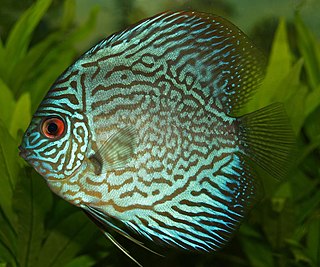
Symphysodon is a genus of cichlids native to the Amazon river basin in South America. Due to their distinctive shape, calm behavior, many bright colors and patterns, and dedicated parenting techniques, discus are popular as freshwater aquarium fish, and their aquaculture in several countries in Asia is a major industry. They are sometimes referred to as pompadour fish. The discus fish has attracted a cult following of collectors and has created a multimillion dollar international industry complete with shows, competitions, and reputable online breeders.

The neon tetra is a Freshwater fish of the characin family of order Characiformes. The type species of its genus, it is native to blackwater and clearwater streams in the Amazon basin of South America. Its bright colouring makes the fish visible to conspecifics in the dark blackwater streams, and is also the main reason for its popularity among freshwater fish hobbyists, with neon tetras being one of the most widely kept tropical fish in the world.

The Amazon basin is the part of South America drained by the Amazon River and its tributaries. The Amazon drainage basin covers an area of about 7,000,000 km2 (2,700,000 sq mi), or about 35.5 percent of the South American continent. It is located in the countries of Bolivia, Brazil, Colombia, Ecuador, Guyana, Peru, Suriname, and Venezuela, as well as the territory of French Guiana.

Tetra is the common name of many small freshwater characiform fishes. Tetras come from Africa, Central America, and South America, belonging to the biological family Characidae and to its former subfamilies Alestidae and Lebiasinidae. The Characidae are distinguished from other fish by the presence of a small adipose fin between the dorsal and caudal fins. Many of these, such as the neon tetra, are brightly colored and easy to keep in captivity. Consequently, they are extremely popular for home aquaria.

Hyphessobrycon is a genus of freshwater fish in the family Characidae. These species are among the fishes known as tetras. The genus is distributed in the Neotropical realm from southern Mexico to Río de la Plata in Argentina. Many of these species are native to South America; about six species are from Central America and a single species, H. compressus is from southern Mexico.

The Serpae tetra, also known as the Red Minor tetra, Jewel tetra or Callistus tetra, is a species of tetra, a tropical freshwater fish of the characin family of order Characiformes. It is native to the Amazon River drainage in Brazil, Peru, Paraguay, Bolivia and northern Argentina. The fish can be found in slow moving or still backwater including, ponds, small lakes, and streams. In the wild, it forms aggregations around vegetation and tree roots, and thrives when the water temperature is 22-27 °C (72-82 °F).
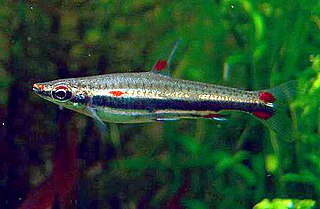
The pencil fishes are a family (Lebiasinidae) of freshwater fishes found in Costa Rica, Panama, and South America. They are usually small and are known as ornamental fishes in aquaria, including popular fishes such as the various pencil fish and the splashing tetra.

Glass knifefishes are fishes in the family Sternopygidae in the order Gymnotiformes. Species are also known as rattail knifefishes.
Corydoras narcissus, commonly known as the long nosed arched cory, is a freshwater fish belonging to the Corydoradinae subfamily of the family Callichthyidae, native to the Madeira and Purus river basins in Amazonian Brazil. It has a longer, more concave ("saddle-shaped") nose, but its color pattern resembles that also seen in a few other Corydoras species from the western Amazon basin, as well as Brachyrhamdia thayeria; they all have spiny fins with a painful but not dangerous venom and their similarity is an example of Müllerian mimicry. C. narcissus generally is an uncommon species in its range.

The rummy-nose tetra is a species of tropical freshwater characin fish originating in South America, popular among fishkeepers as a tropical aquarium fish. One of many small tetras belonging to the same genus, it is on average 5 cm (2 in) long when fully grown. The fish is one of several very similar species including Hemigrammus bleheri, and Petitella georgiae, and it is possible that more recently collected specimens available in the aquarium trade are members of one or other of these similar species. The common name applied to most of these fishes is "rummy-nose tetra", though other common names are in circulation.

The blackline rasbora is a fish of the family Cyprinidae found in Asia in the Mekong, Chao Phraya, and Mae Klong basins, and also the northern Malay Peninsula. In the aquarium trade, it is known by a variety of other names, including red-tailed rasbora, bora bora rasbora, and brilliant rasbora.

Thayeria boehlkei is a species of characin fish endemic to the Amazon river basin and Araguaia river, in Peru and Brazil respectively. The species is popular with aquarium hobbyists where it is traded under a variety of common names including blackline penguinfish, blackline thayeria, hockey-stick tetra, penguin fish and penguin tetra.
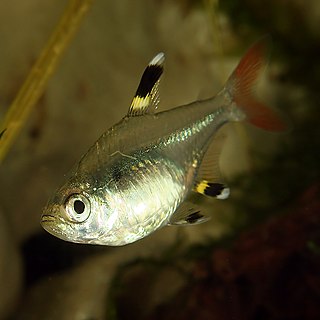
Pristella maxillaris is a species of characin in the genus Pristella, and is commonly known as the X-ray fish or X-ray tetra because of its translucent body. It is a widely distributed and adaptable fish, found in the Amazon and Orinoco basins, as well as coastal rivers in the Guianas in both acidic and alkaline waters. Unlike most other characins, it is tolerant of slightly brackish water. It is small and lives in large groups, and males can be distinguished from females by being smaller and thinner than the females. Like most other tetras, it feeds primarily on small insects and planktonic animals.

Bryconops is a genus of freshwater fish in the family Iguanodectidae from South America. It consists of small fish, all under half-a-foot long, with slender bodies and silvery scales, though there is some mild color variation. Several species can be identified by way of a humeral patch, and others have a reddish ocellus, or eyespot, on one or both lobes of the dorsal fin.

Hemigrammus ocellifer is a South American freshwater fish, also described by the synonyms Hemibrycon ocellifer and Tetragonopterus ocellifer. Common names include beacon fish, beacon tetra, head-and-tail light tetra and head-and-taillight tetra. It is found in the rivers of Guyana, Suriname, French Guiana, and the Amazon Basin of Brazil and Peru.

Hemigrammus is a genus of freshwater fish in the family Characidae native to South America and commonly seen in the aquarium trade. These are medium-small tetras where the largest species reach up to around 11 cm (4.3 in).
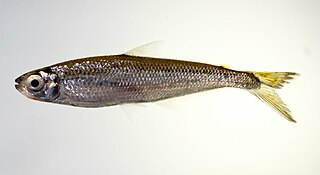
Iguanodectes is a genus of freshwater fish found in tropical South America, with eight currently described species. They are all small tetras, none longer than 5 inches, and often have attractive silvery or striped scales, which makes them a target for the ornamental fish industry. Alongside the genus Piabucus, it is in the subfamily Iguanodectinae, which in turn is in the family Iguanodectidae. The genus Bryconops, which is also in Iguanodectidae, makes up a sister clade to Iguanodectinae.
Petitella georgiae, the false rummy-nose tetra, is a species of characin found in Amazon Basin in Brazil and Peru. It is a very popular aquarium fish. It is the sole member of its genus, but resembles two species from another genus, Hemigrammus bleheri and H. rhodostomus. It is distributed in the upper Amazon basin in Peru, Rio Purus, Rio Negro, and Rio Madeira basins. Some specimens classified as P. georgiae have a black stripe in the caudal peduncle extending forwards into the body, surmounted above by a thin iridescent gold line.
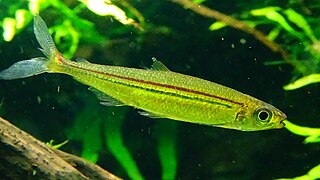
Iguanodectinae is a subfamily of small freshwater fish in the family Iguanodectidae. They are most prominently found in the Amazon river basin and its major tributaries, but they are also known from the Tocantins, Orinoco, and Paraguay rivers. It has two genera, Piabucus and Iguanodectes. Some species in the subfamily are taken from the wild for aquariums, like the red- and green-line lizard tetras. There is minor, but ongoing, debate regarding its taxonomy.

















